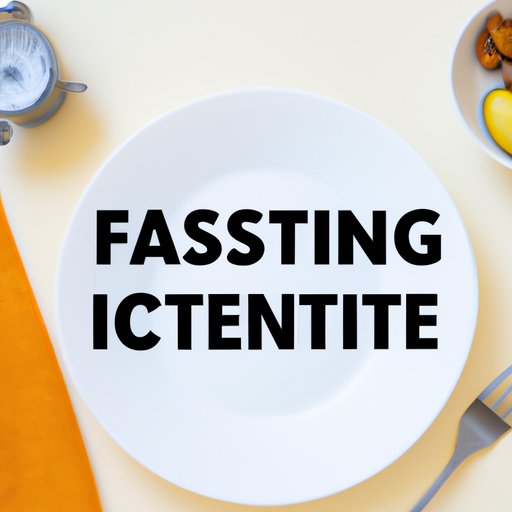
I. Introduction
Intermittent fasting has recently become a trendy concept in the world of health and fitness, but it is also rooted in ancient practices. It consists of cycling through periods of eating and fasting, allowing for the body to rest, recover, and reset. Potential benefits can include weight loss, improved metabolic health, and lower risk of certain diseases.
In this article, we’ll explore why intermittent fasting might be a great addition to your lifestyle and how to get started. Whether you’re a beginner or someone looking to jump back on the wagon, we’ve got you covered. So, let’s get started!
II. The “What, Why, and How” Method
Intermittent fasting is an eating pattern that involves restricting calorie intake for a certain period of time. There are several approaches to fasting, including the 16:8 method, where one eats during an eight-hour window and fasts for the remaining sixteen hours. There’s also the 5:2 method, where one eats normally for five days and restricts calorie intake to 500-600 calories for the other two non-consecutive days.
The potential benefits of intermittent fasting are numerous. They include weight loss, improved metabolic health, and reduced inflammation. Fasting can also lower the risk of heart disease, Type II diabetes, and certain cancers.
Starting out with intermittent fasting can be overwhelming, but there are ways to ease yourself into it. Start by gradually lengthening the fasting period or shortening the eating window. Make sure to prioritize hydration and consume an adequate amount of nutrients during your eating window.
III. Intermittent Fasting for Beginners
The fundamentals of intermittent fasting can be summed up quite simply: it’s all about switching up when you eat rather than what you eat. For beginners, an easy-to-follow schedule is as follows:
- Week 1: Fast for 12 hours, eat for the remaining 12 hours. Try to stick to foods that are nutrient-dense, such as fruits and vegetables.
- Week 2: Fast for 13 hours, eat for the remaining 11 hours. Focus on protein, fiber-rich foods.
- Week 3: Fast for 14 hours, eat for the remaining 10 hours. Add healthy fats like nuts and seeds into your diet.
- Week 4: Fast for 16 hours, eat for the remaining 8 hours. Aim for a well-rounded, balanced meal.
Remember, listen to your body. If you feel lightheaded or sick, take a step back and adjust.
IV. The “Myth-Busting” Approach
There are many myths surrounding fasting, but the truth is that it is a safe and effective way to improve metabolic health and lose weight. One common myth is that fasting slows down your metabolism, but in reality, it can improve it by reducing insulin resistance.
Another concern is muscle loss, but studies have shown that it doesn’t lead to significant muscle loss unless combined with extreme calorie restriction. Additionally, contrary to popular belief, fasting does not necessarily lead to overeating or bingeing.
V. The “Step-by-Step” Approach
Starting out with intermittent fasting can be intimidating, but with a clear plan in place, it becomes much more manageable. Here are some simple steps to get started:
- Set a target eating window that works for your lifestyle.
- Gradually increase your fasting period in increments of one hour per week.
- Make sure to maintain healthy eating habits during your eating window.
- Stay hydrated and prioritize nutrient-dense foods while fasting.
VI. The “Personal Journey” Approach
Starting out with intermittent fasting can be a personal journey, and it’s important to take things at your own pace. One person’s experience may not be the same as another’s, but it can inspire you to try it out for yourself.
Personally, I found that the most significant benefit of intermittent fasting was the mental clarity and energy I gained during the fasting period. Additionally, knowing that I am giving my body a break from constantly digesting food and allowing for it to repair and regenerate is incredibly rewarding.
VII. The “Meal Planning” Approach
Meal planning is crucial when it comes to intermittent fasting. When you’re under a tight eating window, planning ahead can make the process much more straightforward. Make sure to prep your meals ahead of time, so you’re not caught off-guard when hunger strikes.
Some meal ideas could include baked sweet potatoes and chicken breasts, overnight oats with fruit, or roasted vegetables with quinoa. Make a grocery list beforehand, so you don’t find yourself scrambling for ingredients.
VIII. The “FAQs” Approach
Here are some frequently asked questions about intermittent fasting:
Q: Can I drink liquids while fasting?
A: Yes, you can drink water, black coffee, and herbal tea while fasting.
Q: Can I still exercise while fasting?
A: Yes, you can still exercise while fasting, but make sure to listen to your body and adjust if needed.
Q: Can I intermittent fast if I have diabetes or another medical condition?
A: It’s best to consult with your doctor before starting intermittent fasting if you have a medical condition.
IX. Conclusion
Intermittent fasting can be a great addition to anyone’s lifestyle, regardless of their health goals. Remember to approach it at your own pace and be lenient with yourself. Focus on nutrient-dense foods, stay hydrated, and plan your meals ahead of time.





